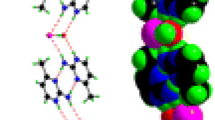Abstract
The novel organic–inorganic hybrid salt [(C5H5N)2CH2][Hg2Cl6] was synthesized, isolated as pure white powder and fully characterized by FTIR, multinuclear NMR, UV–Vis spectroscopy and powder-X-ray diffraction studies. The molecular structure displays organic dicaions [(C5H5N)2CH2]2+ and distinctive dimeric anions [Hg2Cl6]2−. Within any indivisual [Hg2Cl6]2− unit, each Hg center is souronded by four Cl atoms (two terminal and two bridging Cl ones) adopting a distorted tetrahedral geometry. The terminal Cl atoms are covalently bonded to Hg with an average bond disntance of 2.32(5) Å and Cl–Hg–Cl angle of 138.14(5)°. In contrast the two bridging Cl ligands to Hg centers have relatively longer mean bond length of 2.51(5) Å and smaller Cl–Hg–Cl bond angle of 93.68(5)°. The edge Cl–Cl are shared by the two roughly tetrahedra to form the dimeric [Hg2Cl6]2−. The relatively large mean Cl–Hg–Cl angle of the terminal Cl atoms (138.14°) and small angle of the bridging ligands (93.68°) indicate a considerable deviation from the ideal tetrahedral geometry. Noteworthy, within each [Hg2Cl6]2− unit, the Hg1…Hg2 distance [3.41(3) Å] is slightly shorter than the sum of the van der Waals radii for Hg(II) indicating a rather weak mercurophilic interaction.
Graphical Abstract
The novel organic-inorganic hybrid salt [(C5H5N)2CH2][Hg2Cl6] was synthesized, isolated as pure white powder and fully characterized by FTIR, multinuclear NMR, UV-vis spectroscopy and powder-X-ray diffraction studies.








Similar content being viewed by others
References
House DA, Robinson WT (1994) Chloromercury(II) anions. Coord Chem Rev 155:533–586
Bowmaker GA, Harris RK, Oh S (1997) Solid-state NMR spectroscopy of mercury compounds. Coorination Chem Rev 167:49–94
Bowmaker GA, Churakov AV, Harris RK, Oh S (1998) Vibrational spectroscopy and solid-state MAS NMR studies of mercury(II) acetate complexes [Hg(X)OAc] Crystal structure of [Hg(CN)OAc]. J Organomet Chem 550:89–99
Milia F, Giannacopoulos E (1985) Proton NMR of the ferroelectric phase transition in (CH3NH3)HgCl3. Jpn J Appl Phys 24:637–639
Liesegang J, James BD, Jiang ZT (1995) Ferroelectricity in inorganic-organic ionic crystals. Integr Ferroelectr 9:189–198
Jiang ZT, James BD, Liesegang J, Tan KL, Gopalakrishnan R, Novak I (1995) Investigation of the ferroelectric phase transition in (CH3NH3)HgCl3. J Phys Chem Solids 56:277–283
Linden A, James BD, Liesegang J, Gonis N (1999) Polynuclear chloromercurate(II) systems in their chloropyridinium salts. Acta Cryst B55:396–409
Al-Ktaifani MM, Rukiah MK (2011) Synthesis and crystal and molecular structures of N, N′-methylenedipyridinium tetrachlorozincate(II) and N, N′-methylenedipyridinium tetrachlorocadmate(II). Chem Pap 65:469–476. https://doi.org/10.2478/s11696-011-0031-4
Al-Ktaifani MM, Rukiah MK (2012) 1,1’-Methylenedipyridinium tetrachloridocuprate(II) and bis[tetrachloridoaurate(III)] hybrid salts by X-ray powder diffraction. Acta Cryst C68:m246–m250. https://doi.org/10.1107/S0108270112031885
Al-Ktaifani MM, Rukiah MK (2012) N, N′-methylenedipyridinium Pt(II) and Pt(IV) hybrid salts: synthesis, crystal and molecular structures of [(C5H5N)2CH2] · [PtCl4] and [(C5H5N)2CH2] · [PtCl6]. Chem Pap 66:1032–1038. https://doi.org/10.2478/s11696-012-0221-8
Al-Ktaifani MM, Sabra MK (2019) 1,1`-Methylenedipyridinium tetranitratocuprate(II): a rare example of organic-inorganic hybrid salt of form [organic dication][Cu(NO3)4]. synthesis, spectroscopic characterizations and molecular structural investigations. Rev Roum Chim 64:469–477
Zidan MD, Al-Ktaifani MM, Allahham A (2016) Optical nonlinearity investigation of the novel organic-inorganic hybrid salt:1,1′-methylenedipyridiniumpentacyanidonitrosoferrate(II)pentahydrate. Acta Phys Pol, A 130:1326–1331. https://doi.org/10.12693/APhysPolA.130.1326
Zidan MD, Al-Ktaifani MM, Allahham A (2016) Third-order nonlinear optical investigations of the 1,1′-methylenedipyridinium tetrachloridocuprate(II) using Z-scan technique. Optik Int J Light Electron Optics 127:4443–4446
Zidan MD, Al-Ktaifani MM, Allahham A (2017) Nonlinear optical study of 1,1’-methylenedipyridiniumbis[tetrachloride gold(III)] hybrid salt. Acta Phys Pol, A 132:1379–1382
Fu W, Wang W, Niu Y, Ng SW (2010) 1,1’-Methylenedipyridinium dichloride monohydrate. Acta Cryst E66:o1211–o1211
Altomare A, Cuocci C, Giacovazzo C, Moliterni A, Rizzi R, Corriero N, Falcicchio A (2013) EXPO2013: a kit of tools for phasing crystal structures from powder data. J Appl Cryst 46:1231–1235. https://doi.org/10.1107/S0021889813013113
Toby BH, Von Dreele RB (2013) GSAS-II: the genesis of a modern open-source all purpose crystallography software package. J Appl Cryst 46:544–549. https://doi.org/10.1107/S0021889813003531
Garci F, Ferjani H, Chebbi H, Ben Jomaaa M, Zida MF (2019) Crystal structure, Hirshfeld surface analysis and physicochemical characterization of bis[4-(dimethylamino) pyridinium] di-l-chlorido-bis[dichloridomercurate(II)]. Acta Cryst E75:1600–1606
Schmidbaur H (2000) The aurophilicity phenomenon: a decade of experimental findings, theoretical concepts and emerging applications. Gold Bulletin 33:3–10
Pyykkö P, Straka M (2000) Ab initio studies of the dimers (HgH2)2 and (HgMe2)2. Metallophilic attraction and the van der Waals radii of mercury. Phys Chem Chem Phys 2:2489–2493
Pandey AK, Usman M, Rath SP (2020) Hg···Hg···Hg interaction stabilizes unusual trinuclear double sandwich structure of mercury(II) porphyrins. Inorg Chem 59:12988–12993
Bondi A (1964) van der Waals volumes and radii. J Phys Chem 68:441–451
Acknowledgements
The authors would thank Professor I. Othman, Director General, Professor A. H. Al-Rayyes, Head of the Radioisotope department, for their support of this work.
Funding
Atomic Energy Commission of Syria
Author information
Authors and Affiliations
Corresponding author
Additional information
Publisher's Note
Springer Nature remains neutral with regard to jurisdictional claims in published maps and institutional affiliations.
Supplementary Information
Below is the link to the electronic supplementary material.
Rights and permissions
About this article
Cite this article
Al-Ktaifani, M.M., Sabra, M.K., Alsharif, A.A. et al. Synthesis, Crystal and Molecular Structure of 1,1ʹ-Methylenedipyridinium [Hexachlorodimercurate(II)]. J Chem Crystallogr 52, 297–303 (2022). https://doi.org/10.1007/s10870-021-00915-z
Received:
Accepted:
Published:
Issue Date:
DOI: https://doi.org/10.1007/s10870-021-00915-z



